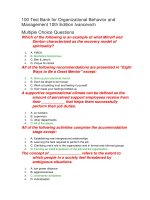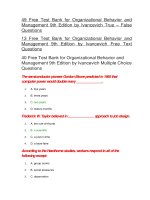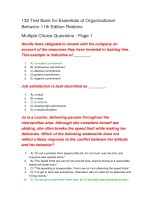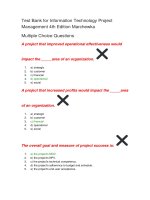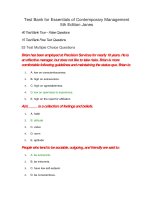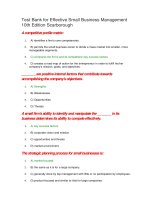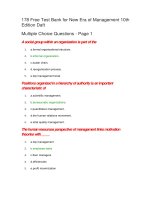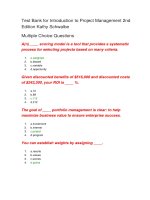Test bank for investments analysis and management 11th edition jones
Bạn đang xem bản rút gọn của tài liệu. Xem và tải ngay bản đầy đủ của tài liệu tại đây (68.01 KB, 11 trang )
Test Bank for Investments Analysis and
Management 11th Edition Jones
Which of the following would not be considered a capital
market security?
1.
2.
3.
4.
a. a 20-year corporate bond
b. a common stock
c. a 6-month Treasury bill
d. a mutual fund share
Series EE bonds must be held at least ------- years in order to
receive the guaranteed minimum rate.
1.
2.
3.
4.
a. 3
b. 5
c. 8
d. 10
Which of the following statements regarding money market
instruments is not true?
1.
2.
3.
4.
a. They tend to be highly marketable.
b. They have maturities from 1 to 3 years.
c. They tend to have a low probability of default.
d. Their rates tend to move together.
Zero-coupon bonds are similar to Treasury bills in that both:
1.
2.
3.
4.
a. are issued exclusively by the U.S. Treasury.
b. are money-market securities.
c. are capital-market securities.
d. are sold at less than par.
What is the biggest difference between an option and a
futures contract?
1.
2.
3.
a. Options are traded on exchanges while futures are not.
b. Options give investors a way to manage portfolio risk while futures do not.
c. Options can be used by speculators to profit from price fluctuations while futures
cannot.
4. d. Options is the right to buy or sell while a futures contract is an obligation to buy
or sell.
Which of the U.S. Treasury securities is always sold at a
discount?
1.
2.
a. Treasury bills
b. Treasury notes
3.
4.
c. Treasury bonds
d. All of the Treasury securities are sold at a discount.
---------------- represent shares of foreign companies kept in
banks.
1.
2.
3.
4.
a. convertible bonds
b. American Depository Receipts (ADRs)
c. asset-backed securities
d. LEAPS
Which of the following statements is true regarding an
investment in mortgage-backed securities?
1.
2.
3.
4.
a. There is little default risk.
b. The stated maturity is generally 10 years.
c. They receive a fixed payment per month.
d. All of the above are true.
Which of the following statements regarding common stocks
is true?
1.
2.
3.
4.
a. The par value of common stock is usually $100.
b. The market value of common stock is equal to its book value.
c. Dividends on common stock are at the discretion of the company.
d. All of the above are true.
Bonds called in are likely to be:
1.
2.
3.
4.
a. bonds already in default.
b. reissued as new bonds with a lower interest rate.
c. reissued as new bonds with a higher interest rate.
d. junk bonds.
If a call option has a $10 strike price, and the underlying
stock is trading at $11, then the option is considered:
1.
2.
3.
4.
a. in the money.
b. at the money.
c. out of the money.
d. worthless.
Treasury STRIPS are most similar to which type of corporate
security?
1.
2.
3.
4.
a. preferred stock
b. premium bond
c. high-yield bond
d. zero-coupon bond
What is the major difference between municipal bonds and
other types of bonds?
1.
2.
3.
4.
a. Municipal bonds are always insured; other bonds are not.
b. Unlike other bonds, municipal bonds sell at a discount.
c. Municipal bond interest is tax-exempt; interest on other bonds is not.
d. There is no brokerage commission on municipal bonds unlike other bonds.
A municipal bond issue that was sold to finance a toll bridge
would most likely be a:
1.
2.
3.
4.
a. general obligation bond.
b. revenue bond.
c. special assessment bond.
d. zero-coupon bond.
Which of the following is not one of the characteristics of the
primary nonmarketable financial assets owned by
most individuals?
1.
2.
3.
4.
a. high liquidity
b. high return
c. often issued by the U.S. government
d. low risk
Savings accounts are ---------- but are not------------.
1.
2.
3.
4.
a. negotiable; liquid.
b. marketable; liquid.
c. liquid; personal
d. liquid; marketable
For U.S. companies, dividends are typically paid:
1.
2.
3.
4.
a. monthly.
b. quarterly.
c. semi-annually.
d. yearly.
If an investor states that Intel is overvalued at 65 times, he is
referring to:
1.
2.
3.
4.
a. earnings per share.
b. dividend yield.
c. book value.
d. P/E ratio.
Fannie Mae is an example of a:
1.
2.
a. federal agency
b. quasi-federal agency
3.
4.
c. federally dependent agency
d. federally sponsored agency
An unsecured bond is known as a:
1.
2.
3.
4.
a. debenture
b. indenture
c. mortgage bond
d. junk bond
Interest on bonds is typically paid:
1.
2.
3.
4.
a. monthly
b. quarterly
c. semiannually
d. annually
If a preferred stock issue is cumulative, this means:
1.
2.
3.
4.
a. dividends are paid at the end of the year.
b. dividends are legally binding on the corporation.
c. unpaid dividends will be paid in the future.
d. unpaid dividends are never repaid.
Treasury bonds generally have maturities of:
1.
2.
3.
4.
a. 5 to 15 years
b. 5 to 30 years
c. 10 to 20 years
d. 10 to 30 years
The largest single institutional owner of common stocks is:
1.
2.
3.
4.
a. mutual funds.
b. insurance companies.
c. pension funds
d. commercial banks
A corporate bond with a rating of BBB- is considered to be
which of the following?
1.
2.
3.
4.
a. non-investment grade
b. investment grade
c. speculative grade
d. junk, or high-yield
What will a bond be worth on the day it matures?
1.
2.
3.
4.
a. $0
b. $100
c. its face value
d. impossible to determine
The coupon rate is another name for the:
1.
2.
3.
4.
a. market interest rate.
b. current yield.
c. stated interest rate.
d. yield to maturity
Treasury bills are traded in the --------------------- .
1.
2.
3.
4.
a. money market.
b. capital market.
c. government market.
d. regulated market.
Which of the following statements is true regarding assetbacked securities (ASB)?
1.
2.
3.
4.
a. They offer relatively high yields.
b. They have relatively long maturities.
c. They generally have low credit ratings.
d. All of the above are true.
Bonds trade on an accrual interest basis. This means an
investor:
1.
2.
a. can sell a bond at any time without losing the interest that has accrued.
b. can buy a bond at any time and gain the interest accrued from the time of the
last payment.
3. c. can sell a bond at any time and retain the interest portion of the bond.
4. d. buy a bond at any time and receive an immediate interest check.
Which of the following 10-year, AAA rated bonds would have
the lowest yield?
1.
2.
3.
4.
a. corporate bond.
b. insured municipal bond.
c. U.S. Treasury bond.
d. mortgage-backed bond.
Each point on a bond quote represents:
1.
2.
3.
4.
a. $100
b. 1 percent of $100
c. 1 percent of $1000
d. $1000
The premium on an option is the:
1.
2.
3.
4.
a. par value of the option.
b. price of the option.
c. book value of the option.
d. price at which a security may be bought or sold using the option.
TIPS adjust for inflation by adjusting the rate of interest paid
on the bond.
1.
2.
True
False
Treasury notes represent the nontraded debt of the U.S.
government.
1.
2.
True
False
The major bond rating service is Dun & Bradstreet.
1.
2.
True
False
An example of indirect investing would be buying shares in a
mutual fund.
1.
2.
True
False
Term bonds have a single maturity.
1.
2.
True
False
Bond ratings are primarily used to assess interest rate risk.
1.
2.
True
False
Investors in high tax brackets would be unlikely to invest in
municipal bonds.
1.
2.
True
False
Most futures contracts are not exercised.
1.
2.
True
False
The par value on common stock sets the value that
stockholders will receive in case of bankruptcy.
1.
2.
True
False
All U. S. government securities are considered marketable
securities.
1.
True
2.
False
The major attraction of municipal bonds is their extremely
low risk.
1.
2.
True
False
The earnings retention rate is calculated as 1 – dividend
yield.
1.
2.
True
False
In the case of a corporate bankruptcy, bondholders are paid
before any distributions are paid to preferred or
common stockholders.
1.
2.
True
False
Marketable securities all fall into the category of capital
market securities.
1.
2.
True
False
LEAPS have maturities dates up to 10 years.
1.
2.
True
False
If a bond has a coupon greater than the current market yield,
it should be selling at a premium.
1.
2.
True
False
The deeper the discount on a zero-coupon bond, the lower
the effective return.
1.
2.
True
False
Money market securities generally carry a low chance of
default.
1.
2.
True
False
Direct investing involves trades made by directly purchasing
shares of a financial intermediary.
1.
2.
True
False
The capital market includes both fixed-income and equity
securities.
1.
2.
True
False
Nonmarketable investments would include savings accounts
at banks and Treasury bills.
1.
2.
True
False
The return on a zero-coupon bond is derived from the
difference between the purchase price of the bond and
its par value.
1.
2.
True
False
The money market security most often used a benchmark for
the risk-free rate is money market deposit account
rate.
1.
2.
True
False
The rate spreads between the different money market
securities of the same term tend to be quite large.
1.
2.
True
False
Callable bonds attract investors because they can be
redeemed early.
1.
2.
True
False
A corporate investor in a 34% marginal income tax bracket
can buy bonds issued by a petroleum exploration
company yielding 10.606%. The investor should be
willing to buy tax-exempt municipal bonds of similar
quality yielding what percent or higher?
Answer Given
10.606(1 - .34) = 7.00 percent
Distinguish between direct and indirect investing.
Answer Given
Direct investing – buy bonds and stocks. Indirect investing – buy mutual funds,
contribute to pension plans, buy life insurance policies.
In what sense is a stock selling for 12 times earnings
“cheaper” than a stock with a P/E ratio of 20?
Answer Given
In that investors are willing to pay only 12 times above earnings for one stock but
are willing to pay the higher “price” of 20 times above earnings for the other.
How is the earnings retention rate related to the dividend
payout rate?
Answer Given
Earnings retention rate = 1 - dividend payout rate
What are some advantages of asset-backed securities to
investors?
Answer Given
High yields with manageable risk.
Why is the ex-dividend date before the holder-of-record
date?
Answer Given
So that paperwork can be completed to show correct owners.
The par value of Blaze, Inc. common stock is $0.50, the
earnings per share is $4, the market price is $60, the
dividend per share is $1. Calculate the payout ratio.
Answer Given
Payout rate = $1/$4 = 0.25 = 25%
Do the stock options markets help stabilize or destabilize the
stock markets? Explain.
Answer Given
Options should be a stabilizing force if options are used to hedge stock positions.
Options might be destabilizing if used for speculation.
Explain how writing option contracts (both puts and calls)
can generate income for owners of the underlying
stock.
Answer Given
The writer keeps the option premium regardless of whether or not the option is
exercised.
Compare the cash flows an investor expects from coupon
bonds, zero-coupon bonds, and preferred stock.
Answer Given
Coupon bonds – annuity of interest payments plus lump sum of principal at
maturity. Zero-coupon bonds – principal at maturity. Preferred stock – annuity ad
infinitum (perpetuity)
Rank (lowest to highest) the following securities in terms of
the risk-expected return tradeoff from the investors’
viewpoint: common stock, corporate bonds, U. S.
Treasury bonds, options, preferred stock..
Answer Given
U. S. Treasury bonds, corporate bonds, preferred stock, common stock, options
What are two direct and one indirect method for individuals
to invest in foreign stocks?
Answer Given
Buy securities directly through exchanges or as American depository receipts and
indirectly through mutual funds.
What stated coupon rate would a taxable corporate bond
have to have to be comparable to a municipal bond
with a coupon rate of 7 percent if the investor is in the
28 percent tax bracket?
Answer Given
9.72% = .071-.28
How do asset-backed securities improve the flow of funds
from savers to borrowers?
Answer Given
Asset-backed securities can be sold to a broader market of investors than the
underlying securities.
The par value of Blaze, Inc. common stock is $0.50, the
earnings per share is $4, the market price is $60, the
dividend per share is $1. Calculate the dividend yield.
Answer Given
Dividend yield = $1/$60 = 0.0167 = 1.67%
How is the total book value of equity affected by stock
splits?
Answer Given
Stock splits do not affect total value of equity or the individual accounts, other than
the number of shares outstanding and the par value.
